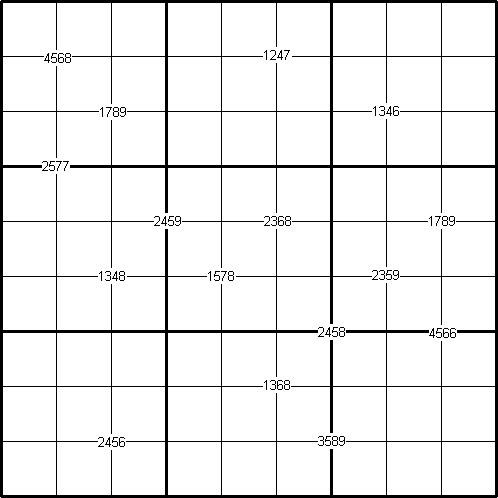Skip over navigation



Or search by topic
Number and algebra
Geometry and measure
Probability and statistics
Working mathematically
Advanced mathematics
For younger learners
Quadruple Clue Sudoku
Age 11 to 16
Challenge Level 





- Problem
- Student Solutions
By Henry Kwok


Rules of Quadruple Clue Sudoku
This is a variation of sudoku on a "standard" 9x9 grid which
contains a set of special clue-numbers. These are small numbers
provided by sets of 4 small digits. Each set of 4 small digits in
the intersection of two grid lines stands for the numbers in the
four cells of the grid adjacent to this set.
The remaining rules are as in a "standard" sudoku, and the
object of the puzzle is to fill in the whole 9x9 grid with numbers
1 through 9 (one number per cell) so that each row, each column,
and each of the nine 3x3 boxes must contain all the nine different
numbers 1 through 9.
Here is a brief explanation of how the special clue-numbers
work. It can be seen that the 4 adjacent cells around each set of 4
small digits overlap one or more sets of adjacent cells with 4
small digits. For example, in the puzzle, taking the two sets of
adjacent cells with small digits {4568} and {1789}, we find that
they overlap at the cell with the number 8.
The rest of the puzzle is solved in the same way through
logical deduction using the usual sudoku techniques and by
determining the numbers in the cells in one set that overlap the
cells in other sets.
You may also like
Consecutive Numbers
An investigation involving adding and subtracting sets of consecutive numbers. Lots to find out, lots to explore.
Tea Cups
Place the 16 different combinations of cup/saucer in this 4 by 4 arrangement so that no row or column contains more than one cup or saucer of the same colour.
Counting on Letters
The letters of the word ABACUS have been arranged in the shape of a triangle. How many different ways can you find to read the word ABACUS from this triangular pattern?

